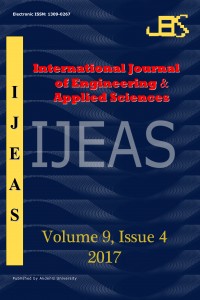Abstract
References
- [1] SAP2000 V-19 CSI. Integrated finite element analysis and design of structures basic analysis reference manual, Berkeley, USA.
- [2] DBYBHY-2007, Deprem bölgelerinde yapılacak binalar hakkında yönetmelik, Bayındırlık ve İskan Bakanlığı, Ankara, 2007.
- [3] FEMA-356, Prestandard and commentary for seismic rehabilitation of buildings, Report No. FEMA-356, Federal Emergency Management Agency, Washington, D.C., 2000.
- [4] Mander, J.B., Priestley, M.J.N. and Park, R., Theoretical stress-strain model for confined concrete. ASCE, 114(8), 1804-1826, 1988.
- [5] İnel, M., Özmen, Hayri B., Effects of plastic hinge properties in nonlinear analysis of reinforced concrete building, Engineering Structures, 28(11):1494-1502, 2006.
- [6] SEMAp, Sargı etkisi modelleme analiz programı, 2008, Tubitak proje no: 105M024.
- [7] Fardis, M.N., Biskinis D.E., Deformation of RC members, as controlled by flexure or shear, In: proceedings of the international symposium honoring Shunsuke Otani on performance-based engineering for earthquake resistant reinforced concrete structures, 2003.
- [8] İnel, M., Çelik, S., Özmen, Hayri B., Önür, Ö., İleri yönlenmeli deprem kayıtları etkisindeki mevcut betonarme binaların deplasman taleplerinin doğrusal elastik olmayan zaman tanım alanında analizle değerlendirilmesi, Yedinci Ulusal Deprem Mühendisliği Konferansı, İstanbul, Türkiye, 2011.
- [9] İnel, M., Önür, Ö., Özmen, Hayri B., Çelik, S., İleri yönlenmeli deprem kayıtları etkisindeki mevcut betonarme binaların deplasman taleplerinin doğrusal elastik zaman tanım alanında analizle değerlendirilmesi, Yedinci Ulusal Deprem Mühendisliği Konferansı, İstanbul, Türkiye, 2011.
- [10] Bray, Jonathan D., Rodriguez-Marek, A., Characterization of forward-directivity ground motions in the near-fault region, Soil Dynamics and Earthquake Engineering, 815-828, 2004.
- [11] Cao, V.V. and Ronagh, H.R., Correlation between seismic parameters of pulse-type motions and damage indices of low-rise reinforced concrete frames, Soil Dynamics and Earthquake Engineering, 66, 102-112, 2014.
- [12] Sommerville, P.G., Engineering characteristics of near fault ground motion, SMIP Seminar Proceedings, California, 1989.
- [13] Sommerville, P.G., Smith, N.F., Graves, R.W. and Abrahamson N.A, Modifications of empirical strong ground motion attenuation relations to include the amplitude and duration effects of rupture directivity, Seismological Resarch Letters, 68(1), 1997.
- [14] PEER, http://peer.berkeley.edu
Abstract
This study compared displacement demands obtained from linear and nonlinear
time history analyses of 2D and 3D models to investigate how 2D models reflect
3-D models. Estimates of 2D and 3D linear and 2D nonlinear models were also
compared to that of 3D nonlinear model to visualize success of linear and 2D
nonlinear models in seismic displacement estimates of RC buildings. A total of
288 dynamic analyses were performed with 12 different records taking into
account two principal directions of 10-, 15- and 20-storey buildings. Outcomes
of the current study imply that 2D representation of 3D models needs careful
modelling. Buildings are usually designed according to related earthquake code
considering both gravity and seismic loads. Then, an interior frame is used for
2D modelling. The periods of 3D and 2D models need to be closer for proper
representation. Another observation is that the 2D linear elastic models do not
properly represent the 3D nonlinear models. Thus, it is recommended to use 3D
models when linear modelling is preferred. Since 2D nonlinear models represent
reasonably well their 3D nonlinear ones, 2D modelling can be preferred for
buildings with no irregularity due to extensive labor and time required for 3D
nonlinear models.
Keywords
displacement demands 2D and 3D frame models linear and nonlinear analyses time history analysis ground motions with forward directivity effects
References
- [1] SAP2000 V-19 CSI. Integrated finite element analysis and design of structures basic analysis reference manual, Berkeley, USA.
- [2] DBYBHY-2007, Deprem bölgelerinde yapılacak binalar hakkında yönetmelik, Bayındırlık ve İskan Bakanlığı, Ankara, 2007.
- [3] FEMA-356, Prestandard and commentary for seismic rehabilitation of buildings, Report No. FEMA-356, Federal Emergency Management Agency, Washington, D.C., 2000.
- [4] Mander, J.B., Priestley, M.J.N. and Park, R., Theoretical stress-strain model for confined concrete. ASCE, 114(8), 1804-1826, 1988.
- [5] İnel, M., Özmen, Hayri B., Effects of plastic hinge properties in nonlinear analysis of reinforced concrete building, Engineering Structures, 28(11):1494-1502, 2006.
- [6] SEMAp, Sargı etkisi modelleme analiz programı, 2008, Tubitak proje no: 105M024.
- [7] Fardis, M.N., Biskinis D.E., Deformation of RC members, as controlled by flexure or shear, In: proceedings of the international symposium honoring Shunsuke Otani on performance-based engineering for earthquake resistant reinforced concrete structures, 2003.
- [8] İnel, M., Çelik, S., Özmen, Hayri B., Önür, Ö., İleri yönlenmeli deprem kayıtları etkisindeki mevcut betonarme binaların deplasman taleplerinin doğrusal elastik olmayan zaman tanım alanında analizle değerlendirilmesi, Yedinci Ulusal Deprem Mühendisliği Konferansı, İstanbul, Türkiye, 2011.
- [9] İnel, M., Önür, Ö., Özmen, Hayri B., Çelik, S., İleri yönlenmeli deprem kayıtları etkisindeki mevcut betonarme binaların deplasman taleplerinin doğrusal elastik zaman tanım alanında analizle değerlendirilmesi, Yedinci Ulusal Deprem Mühendisliği Konferansı, İstanbul, Türkiye, 2011.
- [10] Bray, Jonathan D., Rodriguez-Marek, A., Characterization of forward-directivity ground motions in the near-fault region, Soil Dynamics and Earthquake Engineering, 815-828, 2004.
- [11] Cao, V.V. and Ronagh, H.R., Correlation between seismic parameters of pulse-type motions and damage indices of low-rise reinforced concrete frames, Soil Dynamics and Earthquake Engineering, 66, 102-112, 2014.
- [12] Sommerville, P.G., Engineering characteristics of near fault ground motion, SMIP Seminar Proceedings, California, 1989.
- [13] Sommerville, P.G., Smith, N.F., Graves, R.W. and Abrahamson N.A, Modifications of empirical strong ground motion attenuation relations to include the amplitude and duration effects of rupture directivity, Seismological Resarch Letters, 68(1), 1997.
- [14] PEER, http://peer.berkeley.edu
Details
| Subjects | Engineering |
|---|---|
| Journal Section | Articles |
| Authors | |
| Publication Date | December 27, 2017 |
| Acceptance Date | December 13, 2017 |
| Published in Issue | Year 2017 Volume: 9 Issue: 4 |


